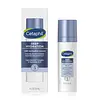What's inside
What's inside
 Key Ingredients
Key Ingredients

 Benefits
Benefits

 Concerns
Concerns

 Ingredients Side-by-side
Ingredients Side-by-side

Water
Skin ConditioningGlycerin
HumectantSorbitol
HumectantCoco-Caprylate/Caprate
EmollientGlyceryl Citrate/Lactate/Linoleate/Oleate
EmulsifyingHelianthus Annuus Seed Oil
EmollientOctyldodecanol
EmollientHexyldecanol
EmollientHexyldecyl Laurate
EmollientDistarch Phosphate
AbsorbentAcrylates/C10-30 Alkyl Acrylate Crosspolymer
Emulsion StabilisingAnhydroxylitol
HumectantButyrospermum Parkii Oil
EmollientCitric Acid
BufferingDicaprylyl Carbonate
EmollientDisodium Cocoyl Glutamate
CleansingGlobularia Alypum Leaf Extract
Skin ConditioningHydrolyzed Hyaluronic Acid
HumectantPanthenol
Skin ConditioningPantolactone
HumectantPhenoxyethanol
PreservativePropylene Glycol
HumectantSodium Benzoate
MaskingSodium Hydroxide
BufferingSodium Polyacrylate
AbsorbentTocopherol
AntioxidantTocopheryl Acetate
AntioxidantXylitol
HumectantXylitylglucoside
HumectantWater, Glycerin, Sorbitol, Coco-Caprylate/Caprate, Glyceryl Citrate/Lactate/Linoleate/Oleate, Helianthus Annuus Seed Oil, Octyldodecanol, Hexyldecanol, Hexyldecyl Laurate, Distarch Phosphate, Acrylates/C10-30 Alkyl Acrylate Crosspolymer, Anhydroxylitol, Butyrospermum Parkii Oil, Citric Acid, Dicaprylyl Carbonate, Disodium Cocoyl Glutamate, Globularia Alypum Leaf Extract, Hydrolyzed Hyaluronic Acid, Panthenol, Pantolactone, Phenoxyethanol, Propylene Glycol, Sodium Benzoate, Sodium Hydroxide, Sodium Polyacrylate, Tocopherol, Tocopheryl Acetate, Xylitol, Xylitylglucoside
Water
Skin ConditioningCaprylic/Capric Triglyceride
MaskingCyclomethicone
EmollientDimethicone
EmollientPersea Gratissima Oil
Skin ConditioningGlycerin
HumectantSteareth-21
CleansingSodium Polyacrylate
AbsorbentCyclopentasiloxane
EmollientTrideceth-6
EmulsifyingPEG/PPG-18/18 Dimethicone
EmulsifyingSteareth-20
CleansingCetyl Alcohol
EmollientIsostearyl Isostearate
EmollientPotassium Cetyl Phosphate
EmulsifyingCetyl Stearate
EmollientStearic Acid
CleansingOlea Europaea Fruit Oil
MaskingTocopheryl Acetate
AntioxidantTheobroma Cacao Seed Butter
EmollientButyrospermum Parkii Butter
Skin ConditioningDimethiconol
EmollientLecithin
EmollientCeramide NP
Skin ConditioningAloe Barbadensis Leaf Juice
Skin ConditioningPhenoxyethanol
PreservativeMethylisothiazolinone
PreservativeXanthan Gum
EmulsifyingSodium Hyaluronate
HumectantSqualane
EmollientCholesterol
EmollientEthyl Linoleate
EmollientBHT
AntioxidantDisodium EDTA
Water, Caprylic/Capric Triglyceride, Cyclomethicone, Dimethicone, Persea Gratissima Oil, Glycerin, Steareth-21, Sodium Polyacrylate, Cyclopentasiloxane, Trideceth-6, PEG/PPG-18/18 Dimethicone, Steareth-20, Cetyl Alcohol, Isostearyl Isostearate, Potassium Cetyl Phosphate, Cetyl Stearate, Stearic Acid, Olea Europaea Fruit Oil, Tocopheryl Acetate, Theobroma Cacao Seed Butter, Butyrospermum Parkii Butter, Dimethiconol, Lecithin, Ceramide NP, Aloe Barbadensis Leaf Juice, Phenoxyethanol, Methylisothiazolinone, Xanthan Gum, Sodium Hyaluronate, Squalane, Cholesterol, Ethyl Linoleate, BHT, Disodium EDTA
 Reviews
Reviews

Ingredients Explained
These ingredients are found in both products.
Ingredients higher up in an ingredient list are typically present in a larger amount.
Glycerin is already naturally found in your skin. It helps moisturize and protect your skin.
A study from 2016 found glycerin to be more effective as a humectant than AHAs and hyaluronic acid.
As a humectant, it helps the skin stay hydrated by pulling moisture to your skin. The low molecular weight of glycerin allows it to pull moisture into the deeper layers of your skin.
Hydrated skin improves your skin barrier; Your skin barrier helps protect against irritants and bacteria.
Glycerin has also been found to have antimicrobial and antiviral properties. Due to these properties, glycerin is often used in wound and burn treatments.
In cosmetics, glycerin is usually derived from plants such as soybean or palm. However, it can also be sourced from animals, such as tallow or animal fat.
This ingredient is organic, colorless, odorless, and non-toxic.
Glycerin is the name for this ingredient in American English. British English uses Glycerol/Glycerine.
Learn more about GlycerinPhenoxyethanol is a preservative that has germicide, antimicrobial, and aromatic properties. Studies show that phenoxyethanol can prevent microbial growth. By itself, it has a scent that is similar to that of a rose.
It's often used in formulations along with Caprylyl Glycol to preserve the shelf life of products.
Sodium Polyacrylate is the sodium salt of polyacrylic acid. It is used as an absorber, emollient, and stabilizer.
This ingredient is a super-absorbent polymer - meaning it can absorb 100 to 1000 times its mass in water. As an emollient, Sodium Polyacrylate helps soften and soothe skin. Emollients work by creating a barrier to trap moisture in. This helps keep your skin hydrated.
Tocopheryl Acetate is AKA Vitamin E. It is an antioxidant and protects your skin from free radicals. Free radicals damage the skin by breaking down collagen.
One study found using Tocopheryl Acetate with Vitamin C decreased the number of sunburned cells.
Tocopheryl Acetate is commonly found in both skincare and dietary supplements.
Learn more about Tocopheryl AcetateWater. It's the most common cosmetic ingredient of all. You'll usually see it at the top of ingredient lists, meaning that it makes up the largest part of the product.
So why is it so popular? Water most often acts as a solvent - this means that it helps dissolve other ingredients into the formulation.
You'll also recognize water as that liquid we all need to stay alive. If you see this, drink a glass of water. Stay hydrated!
Learn more about Water